Exiled to a forsaken continent of outcasts due to unspoken crimes, you lay waiting within the bowels of a ship sailing towards uncertainty, horrid terrors, and a land where death anything but final. After the vessel you travel upon as a prisoner falls prey to spectral corsairs that haunt and raid the waters off the coast of their eternal abode, a ship graveyard, you character dives overboard to escape the slaughter on deck and in the holds below washing ashore with only the clothes on your body and your fists to protect you from the menagerie of bloodlusting wildlife and demonic denizens all of which seek to eviscerate you. Abandoned and destitute is how Grinding Gear Games introduces you to the terrifying continent of Wraeclast as you begin your own Path of Exile.

As a hack-slash-cast action adventure RPG Path of Exile shares many commonalities with the Diablo series (mainly the second game) from a conceptual point-of-view, visual perspective, itemization, monster behaviors and symbiotic interactions; but the game outside of comparison has a unique personality from it’s gameplay and character advancement, to the monsters and bosses, and the environmental atmosphere and aesthetic. Despite my own fondness for Diablo II, which I still play today on occasion, Path of Exile as a core mechanic exhibits everything I wanted Diablo II to be by overcoming the limitations in character development from a system based on obtaining and upgrading skills each level and items dependent on both attribute and class requirements. Instead, Grinding Gear Games has developed a game solely dependent upon itemization, not only the gear you wear and potions you use, but the skills your character has, and the currency spent at vendors or utilize to further augment or reroll the items which have been obtained by slaying monsters.
Gameplay and Character Advancement
At the foundation of it’s concept, Path of Exile is a quarter-view fixed perspective hack-slash-cast action adventure RPG. For those that have played the Diablo or Torchlight series, the core gameplay developed by Grinding Gear Games will be intuitively familiar. What sets this title apart from other similar games is the focus on itemization at a developmental level and how that comes to dictate gameplay through your character. Everything which affects your character except for the passive skill tree is an item. There are no set skill trees for each of the seven (Templar, Marauder, Witch, Scion, Shadow, Duelist, Ranger) classes as skills whether active attacks, replenishing or hasting auras, benefit granting totems, curses which negatively affect monsters, or support skills which add on to or augment your active skills are items that come in the form of gems. Similar to materia from Final Fantasy VII, these skill gems level-up along with your character as they obtain their own experience as you progress through the acts and difficulties in Path of Exile. Equipment which your character wears has colored sockets that fit skill gems which can also be removed by a simple right-click allowing you to keep your skill gems when you obtain new gear. These sockets can also be linked which is how an active skill gem can receive the benefits of a support gem. Though this may read like a nightmare of grinding for gear, Path of Exile also has another archetype of item which provides a system of augmentation and modification to both equipment and skill gems that reduces the necessity of grinding for specific gems and gear with the correct number, color, and linked sockets; these are called orbs. Orbs also fulfill the role of currency in the game, as there is no gold. Coming in a wide variety of augmentation orbs can do the following; turn normal items into magical items of any rarity, reroll the statistical bonuses on magic items, augment the amount and color of gem sockets on an item along with the links between them, provide a superior bonus to an item or gem increasing it’s armor, damage, or skill effect, or refunding a spent passive skill point allowing you to indefinitely reroll your character’s build. What these orbs accomplish in the end is turning what appears to be a gear driven game into an item driven game, which the developers have meticulously and carefully constructed. Due to the variety in affects these orbs have on items of every sort, the imperative to develop a character through their equipment and gems is not held hostage by grinding for desired pieces of loot.
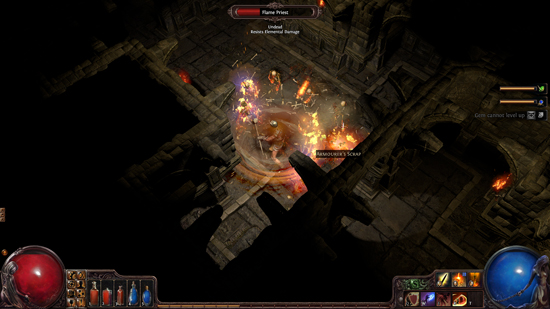
The Passive Skill Tree is a vast web of attribute, health, mana, and defense, damage, accuracy, and speed modifiers, with more substantial modifiers on the periphery of the massive lattice Grinding Gear Games has developed. The deciding factor as to where you start within that web is the class you choose, as each class has a beginning node surrounded by passive skills that are in tune with your character’s archetype. However, there is much more to this tree than the simple modifiers listed above which gives players a varied character advancement of complexity or simplicity with the potential for developing unique but also gimmicked builds. One of my favorites is pairing the passive skill Chaos Inoculation with the unique item Wondertrap velvet slippers; the passive skill reduces your overall health to 1 while granting immunity from chaos damage (a magic damage type not based on an element), the slippers increase the rarity of items dropped by 100% when at low life. If you build a caster around that combination staking the defensive statistic Energy Shield (an additional layer to your characters hitpoints) there is no better to farm for items whether equipment, gems, or orbs. Passive Skill can also be refunded allowing you the freedom to rebuild your character's passive skill build through refund points; these refund points can be obtained either as quest rewards or through spending Orbs of Regret. Though at higher levels you’ll need dozens of orbs to completely retool your passive tree, the opportunity to recreate a character dynamically through passive skills without creating a new character exists; and it is a welcomed mechanic that lets you define your character by more than your class or skills indefinitely without demanding a monster slaughtering grind for Orbs of Regret as you can trade for them.
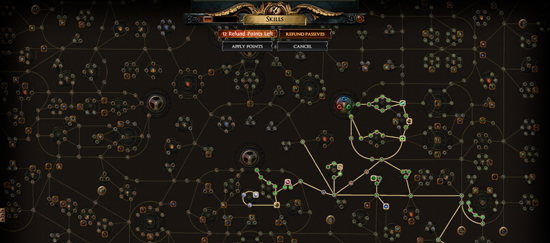
Monsters Repertoire
A key aspect to any hack-slash-cast action RPG are the monsters. They are after all the very things you hack, slash, and cast upon. Though mechanically Path of Exile exhibits creativity in game design, the most visual feature of the developer’s creativity and design rests within the monsters. The creature design sticks to the conceptual atmosphere of a continent laden with horrific and terrifying manifestations, a continental hell on the surface of the world Grinding Gear Games created; which they pulled off remarkably well. Featuring a typical cast of characters from humans to skeletons and undead creatures of many sorts, Path of Exile also has a plethora of truly unique monsters with impeccable details and design elements throughout each act. However, don’t take the hellish metaphor strictly as many of the creatures which lurk within Wraeclast are more alien in appearance rather than demonic. From worm-like aquatic creatures sprouting a morass of tentacles to their more bulbous counterparts, or fang mawed manta rays on legs, malformed bears with doggish features, peacock fan tailed quadruped chimeras, hard-shell backed bipedal dinosauric lizards, mammoth beetles on chitinous arachnid legs, to deadly drapes and ribbon creatures; Path of Exile plays host to a slew of visually unique and creatively designed creatures.
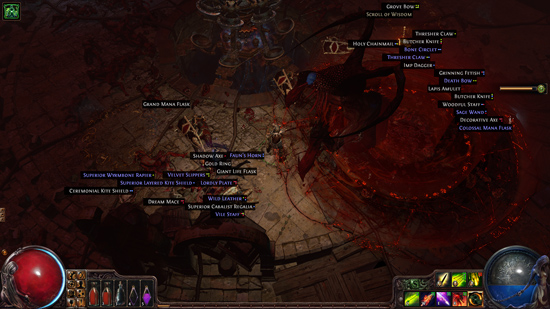
These monsters also exhibit many unique and dynamic behaviors providing new challenges throughout each act of the game. Though once again commonalities with some behaviors seen in Diablo II and Torchlight 2 are present, these instances are rare such as the necromancer archetype found during Act 1 which similar to the Unraveler archetype in Diablo II raises hordes of skeletons. Despite being referred to as avian creatures, the mawed manta rays on legs found in Act 1 and parts of Act 3 indirectly threaten the player with a disastrous attack; as monsters fall to your exploits these creatures scurry amongst the corpses of your victims consuming them in a savage feast, once they have had their fill these creatures spit balls of coalesced flesh and gore which explode on impact causing substantial amounts of damage. The peacock chimeras with incredible speed maneuver away from you until they have enough room to turn and fire bone spikes at machine gun rates, when a pack of these creatures await behind a door the ensuing ambush of damage can be catastrophic. The Rock Golems found in Act 2 have a tendency to curl up into a ball and attempt to roll over you. Many of the monsters throughout the game also utilize gem skill themselves from attacks, to totems, as well as curses and auras.
However it is the attention to environmental seamlessness in how many of the creatures spawn, or present themselves for the slaughter which has been the most interesting experience while traversing Wraeclast. Crab creatures which dwell beneath the sands of Act 1 literally dig themselves to the surface when you step closely to them, while water elemental-esque creatures coalesce from the waves and pools of the same act. The monkeys and gorillas found in the jungled areas of Act 2 descend upon you from the heights of the canopied trees, the rock golems found littering the stone pathways of the same act appear to be static object piles of rock until you tread close enough to them upon which the rocks consolidate into a golem, possessed statutes come to life and walk off of their platforms once you near them, humans whether bandits or Blackguards (the army of the game’s main antagonist, High Priest Dominus) walk out of tents found throughout the zones they inhabit, within the bowels of the games dungeons and crypts spiders will crawl up unseen walls that stretch down into a blackened abyss as you move down caverned rooms with catwalks commonly surrounding you if you aren’t quick enough to maneuver passed them. These dynamic spawning events add another layer to the experience of creature spawning, rather than simply having a mass of monsters which you come into conflict with, these events provide a sharp sense of suspense in both open world areas and dungeon crawls.
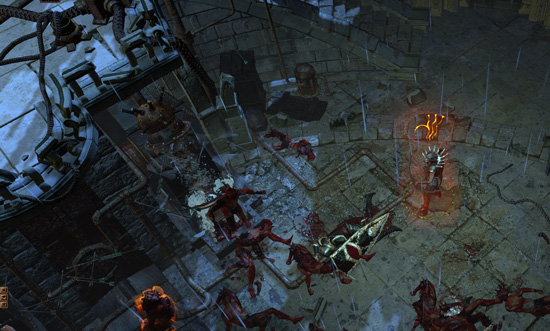
Atmosphere and Aesthetic
Let it be known now that Path of Exile is a mature title, one that is filled with terrifying monsters and horrid scenes of death following righteous and furious battle. Not only is Path of Exile a game that ought be avoided by the faint of heart, this is no kid’s game; but a title that befits the lineage of atmosphere found in the first two Diablo titles, a dark and suspenseful adventure through a forsaken land of nightmarish tribulations and brutality with hordes of monsters lingering just beyond the shadows at the edge of your light radius.
Graphically the game fits the times. Despite seven years of development, Grinding Gear Games has done well creating a visual experience that utilizes the latest technologies Path of Exile is being played on. However, as with the game’s mechanics and creature design, the stunning visual aspects of the game are once more an attribute of creativity more so that substantial quality. Not to depart from the quality of this game, which graphically is a high quality experience, it is the design and aesthetic which truly catch the eye exuding an extraordinary sense of detail from the macro to micro scale.
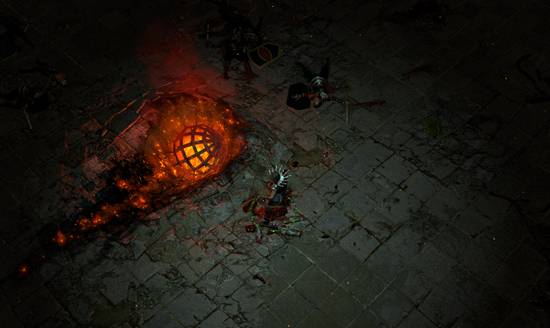
The color palette is fantastic, painting the world in a richness of natural tones Path of Exile does not suffer from the same polarizing and oversaturated sheen of Diablo III and Torchlight 2, which gives this game a much more authentic appeal visually creating an environment which is more realistic than the Saturday morning cartoonish facade found in Diablo III and Torchlight 2. The slate gray stonework of the crypts and dungeons are beautifully cascaded in dark shadows and corridors with a crisp ambience of little light provided by the contrast of rich orange and red hues eminated from torch fires; whereas the outdoor environments have a more vivid palette that fits the unique environments of Wraelcast; the strands and marshes feature browns and yellows in the sands and rocks with dulled greens and tanned grasses amongst the muddy stretches, deep within the caverns of the first act blue hues reflect a dark and mysterious stalagmite strewn underworld. The jungles and forests of Act 2 have a rich vibrancy of color with many sharp hues of green throughout the foliage along with yellows, reds, and violets draping the dark brown tree trunks. Playing more heavily upon the concept of good and evil, or light and dark within Act 3, the earlier areas of a once great and powerful but fallen empire are brightly illuminated by a healthy sun reflecting the clay browns and tans of the stone structures and shingled roofs along with highly detailed wood structures of deep browns similar to the trees found in Act 2. In the later areas of Act 3, where darkness prevails, thick and blackened smoke blots out the sun casting a dark haze over the war torn temple courtyards.
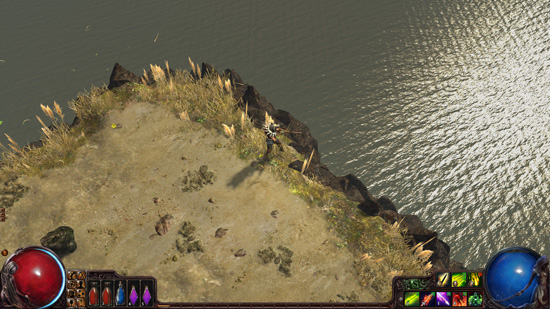
The environments are furthermore given a sensational visual and auditory life of their own with a fine attention to detail. Not only do the colors paint a rich scene, the objects and effects also create an atmosphere that reflect the color palette of each area. Broken ships with rotting wood pilfered by time and the elements fill the Ship Graveyard in Act 1 as the constantly cascading sound of waves ripple throughout the tidal area, the Battlefront zone in Act 3 which leads into the temples fought over by the arch antagonist Dominus and the flailing Gemling empire are strewn with fallen Blackguards and Gemling ribbon creatures many gripped together in the embrace of death, blood splatters the ground where the Blackguards fell commonly around the fortifications of wood erected throughout the once shining granite courtyards all the while the sounds of battle, the clang of steel on stone, the yells and screams of the combatants wades on the periphery with an eerie echo. Deep grooves in that same granite flooring streak across the screen where large steel-spiked balls filled with a furnace of burning material still ignited and smoking emit the only light which penetrates the shadowed zone. The bars and iron doors of the prison cells in Act 1 are rusted with a tarnished dark iron and orange creaking open with the wail of poorly lubricated metal-on-metal, whereas the Riverways in Act 2 are covered with rich grasses and plant life that move and react to your footsteps as you tread across their grounds while fording a delta of streams all under the shaded canopy of towering trees with streaked rays of light penetrating their upper leaves and branches as chirps, squeaks, the rustle of wind, and the trickling of stream water permeates the jungle. The continent of Wraeclast is a rich visual and auditory experience with many subtle details as well as prominent features.
Always Online
As an experience of gameplay, atmosphere, and aesthetic, Path of Exile is a phenomenal accomplishment for such a small yet dedicated development team. However, being a free-to-play title, the game is also home to a micro market. Though the market does not offer play-to-win items or advantages (most of the items you can purchase are pets, character flair, or additional stash tabs), the game requires you to have internet access. It is set up similar to MMOs with a login screen, making the game a server-side administered title. Since the data of gameplay is administered server-side rather than client-side on your end, latency issues arise. Though they have been marginal from my own experience, when the game desynchronizes at the wrong time, you will wake up dead as the saying goes once the server has synchronized gameplay.
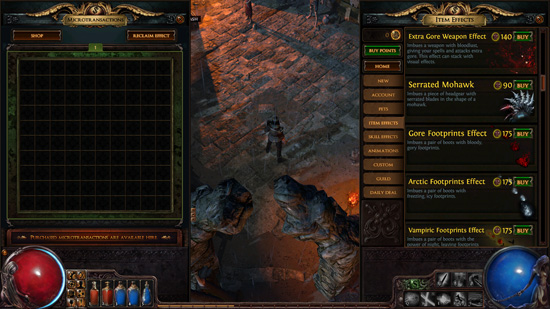
Following seven years of development and years of open and closed beta periods, Grinding Gear Games has officially launched their solo venture, the free-to-play action adventure RPG Path of Exile. Though yet another soft launch, as characters which players developed during the beta periods have carried over following the game’s release, Path of Exile proves that dedicated and creative teams of developers can surpass the bias of being labelled a Diablo clone in producing a similarly styled though high quality and unique action adventure RPG.